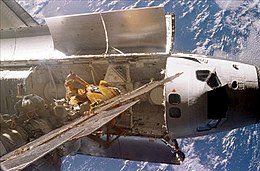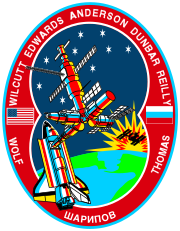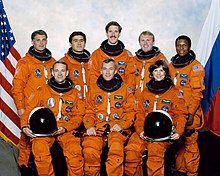This article includes a list of references, related reading, or external links, but its sources remain unclear because it lacks inline citations .(May 2008) |
 Endeavour docked to Mir, as viewed from a window on the Kvant-2 module | |
| Names | Space Transportation System-89 |
|---|---|
| Mission type | Shuttle-Mir |
| Operator | NASA |
| COSPAR ID | 1998-003A |
| SATCAT no. | 25143 |
| Mission duration | 8 days, 19 hours, 48 minutes, 4 seconds |
| Distance travelled | 5,800,000 kilometers (3,600,000 mi) |
| Spacecraft properties | |
| Spacecraft | Space Shuttle Endeavour |
| Landing mass | 114,131 kilograms (251,616 lb) |
| Payload mass | 7,748 kilograms (17,081 lb) |
| Crew | |
| Crew size | 7 |
| Members | |
| Launching | |
| Landing | |
| Start of mission | |
| Launch date | 23 January 1998, 02:48:15 UTC |
| Launch site | Kennedy, LC-39A |
| End of mission | |
| Landing date | 31 January 1998, 22:36 UTC |
| Landing site | Kennedy, SLF Runway 15 |
| Orbital parameters | |
| Reference system | Geocentric |
| Regime | Low Earth |
| Perigee altitude | 359 kilometres (223 mi) |
| Apogee altitude | 382 kilometres (237 mi) |
| Inclination | 51.60 degrees |
| Period | 92.0 min |
| Docking with Mir | |
| Docking port | SO starboard |
| Docking date | 24 January 1998, 20:14:15 UTC |
| Undocking date | 29 January 1998, 16:56 UTC |
| Time docked | 4 days, 20 hours, 41 minutes 45 seconds |
  Left to right - Back row: Wolf, Sharipov, Reilly, Thomas, Anderson; Front row: Edwards, Wilcutt, Dunbar | |
STS-89 was a Space Shuttle mission to the Mir space station flown by Space Shuttle Endeavour, and launched from Kennedy Space Center, Florida on 22 January 1998.





